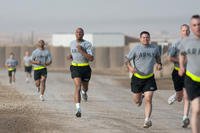What does it mean to be physically fit? I used to think people were above average physically fit because someone could run a marathon or win a powerlifting competition. The truth is, they are good at one or a few elements of fitness, but not all of them. So does that make them "unfit"?
I would not say that, but to accomplish true health and wellness, practicing some diversity with your training will yield more of a well-rounded, physically fit human. Continuing to move well for the latter half of your life depends on this type of multi-goal-oriented focus, versus a singular focus.
General fitness encompasses several essential elements for achieving optimal health and well-being. These elements include strength, endurance, balance, flexibility and mobility. There is nothing wrong with having a primary focus that you love to do out of the list above, but during offseasons each year, add other fitness elements to help you build a broader fitness foundation.
Many individuals focus on a single exercise or activity, believing it is sufficient for their fitness. But consider this: Are you truly fit if you can bench-press 400 pounds but struggle to run a mile? Or can you run 10 miles but find it challenging to squat your body weight or do a pull-up? Research has consistently shown that neglecting one of the five types of exercise can harm your overall health and longevity. It's not about excelling in one area but about achieving a balanced fitness regimen for your long-term well-being. Each type of exercise offers unique benefits, and neglecting any one of them can have negative implications for your overall health and longevity.
Here is why each of these components needs to be part of your life, especially as you age:
Strength
Muscle matters. Being physically strong enables you to perform daily tasks easily and is crucial in preventing injury and maintaining proper posture. Strength training can help you build muscle mass and increase bone density, which is important for overall health, wellness and longevity.
As we age, we start to lose muscle. There must be a concerted effort to work on resistance training of some type (weights, TRX, calisthenics, bands, etc.), otherwise you will not be able to fight the annual catabolic (loss of muscle) effects of aging. See Adding Resistance Training to Your Life.
Endurance
Good cardiovascular endurance means your heart, lungs and circulatory system can work efficiently during physical activity. This activity may start as a walk or easy bike ride and then progress to jogging, backpacking, swimming or other machine cardio options. Training cardio as part of your daily training is important for maintaining a healthy heart and improving your stamina and energy levels throughout the day. See Make Endurance Training Fun.
Balance
Falling is not something you want to do as you age. The risk of breaking a bone (hips, legs and wrists) is too great, but it can be improved by actively working on the leg muscles and balance coordination regularly. Maintaining your balance not only helps prevent falls and injuries but also improves your overall coordination and stability. Balance is our No. 1 tool to avoid injury at any stage in life. See How to Improve Your Balance.
Flexibility and Mobility
These two elements are often overlooked. Still, they are crucial for maintaining a full range of motion in your joints and muscles, and being more flexible and mobile in your joints results in moving with less pain. Improving your flexibility can alleviate muscle stiffness and reduce the risk of injury, while mobility exercises can help you move more freely, with greater ease and with less pain. See Improve Your Flexibility and Mobility.
Here are the three key takeaways:
- Physical fitness comprises strength, endurance, balance and flexibility/mobility, which must be developed for overall health, wellness and longevity.
- Focusing on just one type of exercise or activity may not be enough to achieve overall fitness, as all five elements of fitness have different benefits that contribute to improved overall health and longevity.
- It is fun to be great at any one of these elements of fitness, but being good at all of them will benefit you in the long run.
By working toward balance and excellence across all fitness areas, you're building a strong foundation for your long-term health and well-being and reaping the unique benefits each type of exercise offers. This comprehensive approach can be a powerful motivator for your fitness journey as you move from athlete to active-duty military and into retirement.
Want to Learn More About Military Life?
Whether you're thinking of joining the military, looking for fitness and basic training tips, or keeping up with military life and benefits, Military.com has you covered. Subscribe to Military.com to have military news, updates and resources delivered directly to your inbox.


















